Last Updated: 9 months ago
As I’m sure you know, not all breeds are the same.
Some will find apartments too small to explore, while others may be fine with it. What makes a good apartment cat?
Factors to consider when getting a cat for your apartment:
- Daily schedule: cats require different levels of attention. If you spend most of your time at work, whether at home or away from home, make sure you get a cat that isn’t too demanding.
- Activity level: hyperactive acts aren’t the best for apartments. They’ll either get bored quickly or damage items as they play around the house. Docile, easygoing cats are better in such a case.
- Apartment setting: Some apartments are built with soundproof walls, so the sound of a cat wouldn’t be a problem. But if yours aren’t, make sure you get less vocal cats or avoid them at all if there are complaints.
- Shedding: If you aren’t a fan of cleaning and grooming often, a cat that sheds often isn’t suitable for you. Cats that shed a lot are also not the best for people with allergies.
The Best Cats for Apartments
1. Persian
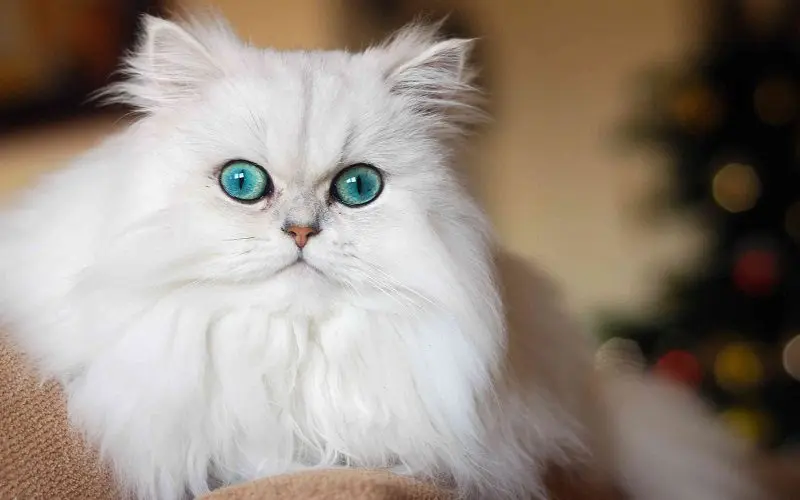
- Origin – Iran (formerly Persia)
- Weight – 7 to 12 pounds
- Height – 10 to 15 Inches
- Temperament – Calm
- Health Issues – Bladder stones, PKD
- Hypoallergenic – No
- Shedding – High
Persian cats are known for being docile, sweet, and calm. They are not hyperactive like some cat breeds.
They will often spend most of the day sleeping, making them great for those living in apartments. Being docile and easygoing doesn’t mean they won’t need playtime.
Ensure you schedule time to pet them.
They are also high-maintenance cats and suffer from various medical conditions, such as bladder stones and polycystic kidney disease.
Still, their sweet nature makes them a worthy companion for apartment life.
2. Scottish Fold
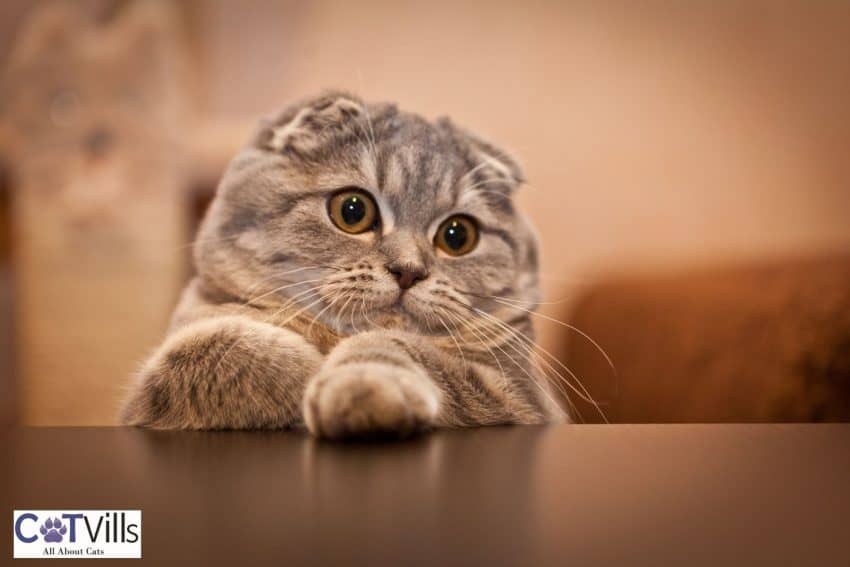
- Origin – Scotland
- Weight – 6 to 9 pounds (Female) 9 – 13 pounds (Male)
- Height – 8 to 10 inches
- Temperament – Calm
- Health Issues – Arthritis, painful joint degenerative diseases
- Hypoallergenic – No
- Shedding – High
Scottish Fold cats are known for their folding ears, compact bodies, friendly nature, and relatively calm temperament. They are not that demanding of attention.
But they enjoy cuddling with their owners. If you spend most of your time away from home, it would be best to get two Scottish Fold cats, as they could keep each other company.
However, they can scratch if not handled properly, so make sure everyone in your household knows how to handle this cat.
Before getting the Scottish Fold, consider that they suffer from arthritis and many other painful joint degenerative diseases.
These conditions result from the genetic mutation causing the folding of the ears.
But this hasn’t stopped people from owning this cat. As long as you can offer the necessary care and maintenance, you should be fine.
3. Maine Coon
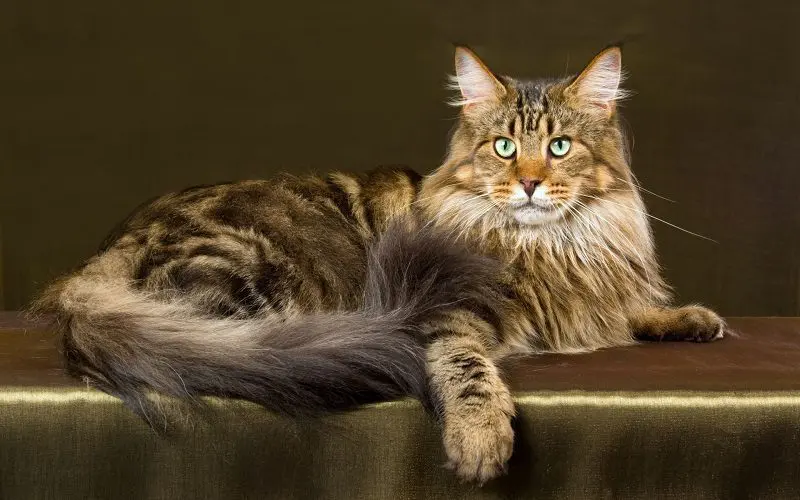
- Origin – United States
- Weight – 8 to 12 lbs. (Female) 15 to 25 lbs. (Male)
- Height – 10 to 16 inches
- Temperament – Calm, friendly, pleasant
- Health Issues – Generally healthy but may be prone to Heart problems and hip dysplasia.
- Hypoallergenic – No
- Shedding – Moderate
With a history associated with France’s last queen, Marie Antoinette, the Maine Coon is another good cat for small apartments.
Also known as the “gentle giants,” Maine Coons are friendly, sociable, and easygoing. For such a large cat, you might think that they need large spaces to explore.
On the contrary, they can keep themselves busy in the available space.
However, make sure all items, such as lamps or electronics, are secured since they may drop them as they move around the house.
You can’t blame them, though. Some of them can grow up to 40 inches from nose to tail.
4. Sphynx
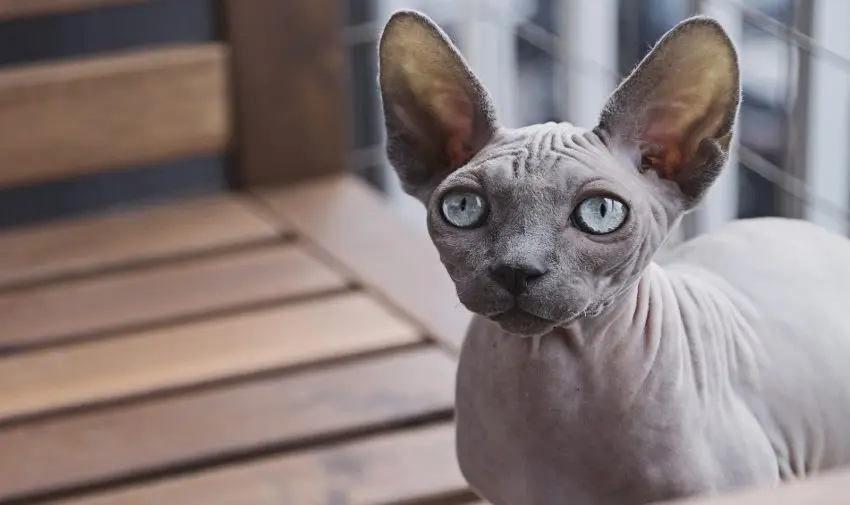
- Origin – Toronto, Canada
- Weight – 10 to 12 lbs.
- Height – 8 to 10 inches
- Temperament – sociable, cuddly
- Health Issues – Skin issues, hypertrophic cardiomyopathy
- Hypoallergenic – No
- Shedding – Low
Now, the Sphynx isn’t your typical-looking cat. Most cat breeds have fur, but this breed has little to no fur, giving them a slightly scary but sweet look.
The best thing about them not having hair is that they are hypoallergenic, making them great for people with allergies.
They also save you from having to clean dander and fur often. Unlike the Maine Coons, they are relatively small, active, friendly, and sometimes cuddly.
They are the best for those with larger apartments due to their higher energy level.
The lack of fur makes them sensitive to sunlight, so be careful when taking them outside, or don’t take them out at all.
5. Ragdoll

- Origin – Riverside, California
- Weight – 8 to 15 (female) 12 to 20 (Male)
- Height – 9 to 11 inches
- Temperament – Calm, affectionate, gentle
- Health Issues – Bladder stones, Obesity, Heart Problems
- Hypoallergenic – No
- Shedding – Moderate
Besides following you around the house, the Ragdoll cat can’t be considered hyperactive. They prefer being held by their owners and are quite friendly to strangers.
Ragdolls are also quite large, so make sure they have enough space to maneuver around the house without knocking over objects.
Like any other cat, even though they are docile, they need mental and physical stimulation once in a while.
So, make sure you engage them with toys, games, and even tricks. They learn pretty fast compared to most cats.
6. Russian Blue
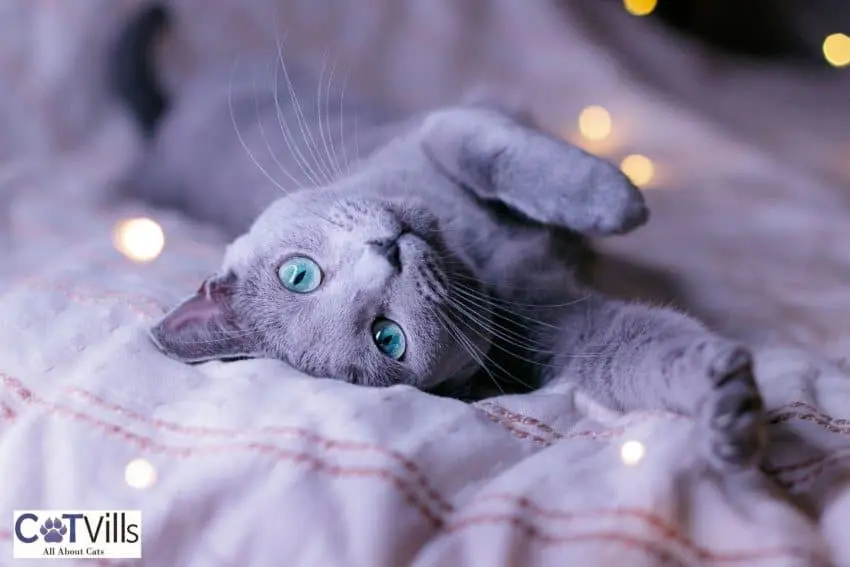
- Origin – Russia
- Weight – 5 to 15 pounds
- Height – 10 inches
- Temperament – Calm, active, non-demanding
- Health Issues – Generally healthy
- Hypoallergenic – No
- Shedding – Moderate
Not much is known about the origin of this cat breed, except that they may have come from Northern Russia.
They are some of the best cat breeds for apartments. Why? They are social but not too demanding.
They are not very curious and may prefer to spend the day in one place, preferably an elevated section.
Russian blue cats are also moderately active, and they will enjoy toys that appeal to their hunting instincts.
They are medium-sized, featuring a greyish coat color, thick fur, and slender body, and they’ll be fine with standard maintenance.
They also don’t shed as many allergens, so they may be suitable for people with allergies.
7. British Shorthair

- Origin – United Kingdom
- Weight – 9 to 17 pounds
- Height – 12 to 14 inches
- Temperament – non-demanding, sweet-natured
- Health Issues – Hypertrophic Cardiomyopathy
- Hypoallergenic – No
- Shedding – Moderate
If there’s one thing that British Shorthairs are known for, it’s their adaptability. They are some of the oldest cat breeds that Romans first used to keep rodents and snakes away.
They then adapted naturally and through selective breeding to fit the UK environment.
They also contain Persian bloodlines, which would explain why they are a bit laid-back, stocky, and have a dense coat.
Since they’ve been around people for the better part of history, they tend to be loyal to their owners, but they may hesitate to bond with strangers.
British Shorthairs are sweet-natured, dignified, easygoing, not very playful, and not very demanding of attention, making them great for apartment living.
8. Exotic Shorthair
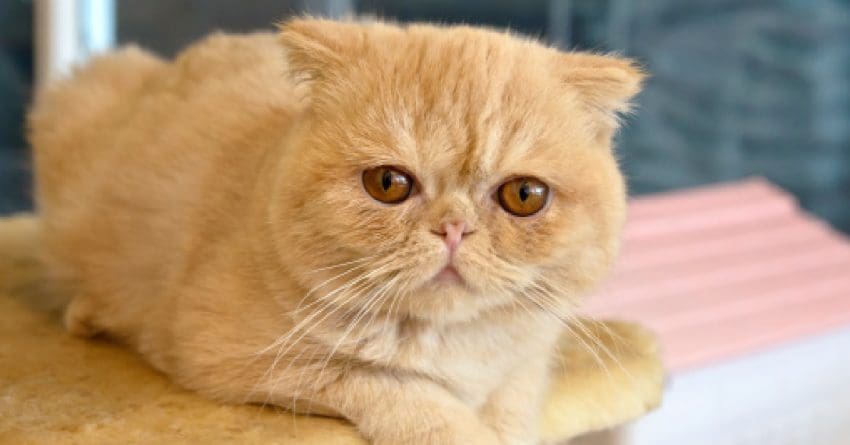
- Origin – United States
- Weight – 7 to 12 pounds
- Height – 10 to 12 inches
- Temperament – Calm, easygoing, non-demanding, and lively
- Health Issues – PKD, progressive retinal atrophy (PRA)
- Hypoallergenic – No
- Shedding – Moderate
Exotic Shorthairs present a viable alternative to those who love the Persian cat but can’t maintain the long, plush coat or find it hard to clean the fur often.
These exotic cats share the same round build, sweet-natured, easygoing, and laid-back traits as the Persian, but they can sometimes be livelier.
When they’re not sleeping on your lap, you’ll find them playing with their favorite toy.
According to Vetstreet, Exotic Shorthairs result from crossing Persians with Russian Blues, American Shorthairs, and Burmese cats, which also have a personality suitable for apartments.
9. American Shorthair

- Origin – Europe and North America
- Weight – 6 to 12 (female) 11 to 15 pounds (Male)
- Height – 8 to 12 inches
- Temperament – mellow, laid-back
- Health Issues – Generally healthy but may be prone to Heart problems and hip dysplasia.
- Hypoallergenic – No
- Shedding – Moderate
Bred as working cats, American Shorthairs are used to keeping people company.
It’s one of the shorthaired cats bred in the United States, though it has bloodlines of cats originating from Europe, such as the British Shorthair.
American Shorthairs are known for being muscular, powerful, and ones that keep themselves busy with anything they find interesting.
They will spend time with their owners occasionally, but they are the best for those looking for a less talkative companion.
Even though they are muscular, American Shorthairs are prone to obesity, so make sure you often engage them in physical and mental stimulation.
10. Birman
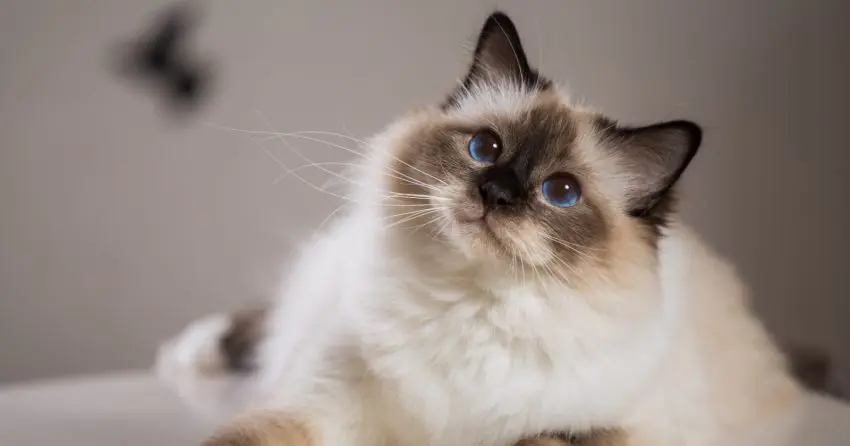
- Origin – Myanmar, and France
- Weight – 6 to 10 (female) 10 to 15 pounds (Male)
- Height – 8 to 10 inches
- Temperament – mellow, laid-back
- Health Issues – Relatively healthy but may be prone to heart problems, hip dysplasia, and obesity.
- Hypoallergenic – No
- Shedding – Moderate
Birmans are some of the most famous cats. And their popularity is warranted due to their striking blue eyes, plush white coat, and wonderful disposition.
They are “independent” cats who will spend most of their time on their own or around you as you handle your activities, but they won’t keep nagging you for attention.
When they need petting, they’ll alert you in a soft voice.
Birman cats are quite intelligent, so make sure to get them interactive toys and mind-stimulating toys.
They are friendly to people, kids, and other pets. So, when possible, you can also get them a companion; any cat or dog breed will do as long as they get along.
11. Burmese
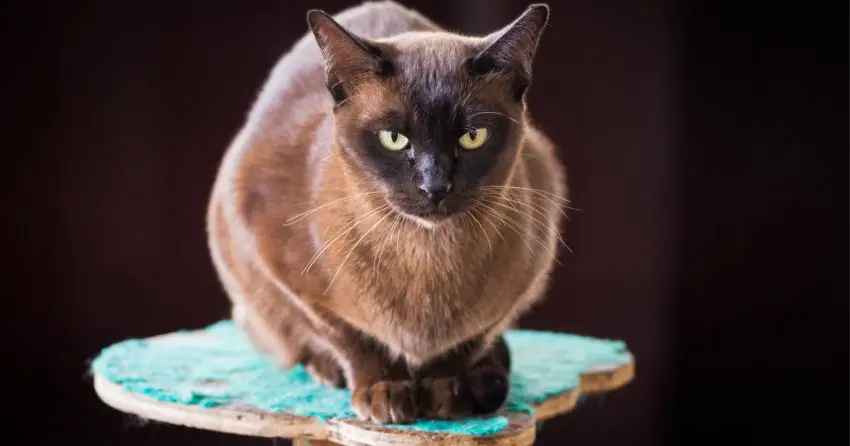
- Origin – Myanmar, and Thailand
- Weight – 6 to 8 (female) 8 to 12 pounds (Male)
- Height – 10 to 12 inches
- Temperament – loyal, intelligent, playful, and needs attention
- Health Issues – Hypokalaemic polymyopathy, Diabetes Mellitus
- Hypoallergenic – No
- Shedding – Moderate
The Burmese are the perfect feline friend for apartment living, featuring a dark-brown coat, expressive golden eyes, and a stocky body.
Unlike some of the other cats I’ve discussed, the Burmese are quite active, especially when they’re young, and they need lots of attention from their owners.
To meet their needs, get them climbing toys such as cat trees or any other interactive toys, and make sure you have enough time to spend with them throughout the day.
If you don’t, then get them a companion, preferably another Burmese cat. As long as they have what they need, the size of the house won’t be a problem.
Cat Breeds That Aren’t Fit For Apartments
As mentioned earlier, not all cats can live in small apartments.
Now that we know those with a good disposition for apartment life, let’s see some of the cats you should avoid.
Siamese Cats
Siamese kitties are some of the most talkative cat breeds. They express most of their feelings vocally, from hunger to anger, to any observation.
Their sound may not only be an issue to those looking for a quiet companion, but it could also lead to noise complaints from neighbors.
Savannah Cats
For starters, Savannah cats are illegal in some states, so you need to check if they are allowed in your state.
Secondly, they are bred from the Serval cat, so they prefer being outdoors and in wide-open spaces most of the time.
Abyssinian
Abyssinian cats can make good companions for any homeowner, but they love space, are hyperactive, and love adventure.
Other cat breeds whose activity level isn’t suited for apartments or small houses include Siberians, Bengals, and Balinese cats.
How to Make a Small Apartment Suitable For Your Cat
Even laid-back cats can feel bored if they lack enough stimulation. But don’t let a small house stop you from getting a feline friend.
Below are some ways you can make your apartment more fun.
Have Some Indoor Plants
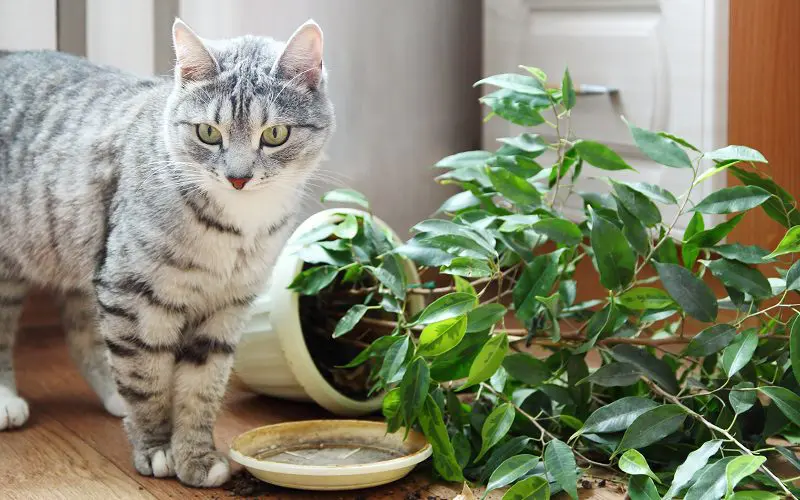
Like their wild cousins, cats sometimes love being in a jungle-like environment. Since you can’t always take them outside, try getting some plants where they can hide.
Some of them can even chew the plants. Make sure the plants aren’t toxic to cats.
Create a Section They Can Climb
Cats also love climbing to elevated sections and observe the world from there. The top of a refrigerator or a shelf would do.
But there’s a more specific toy designed for cats: a cat tree.
They come in various sizes, designs, and tiny rooms where the cat can sleep when they are tired of playing on the tree.
The best thing about cat trees is they allow you to utilize your vertical space.
Get Them a Window View

One of the traits that cats have maintained from their ancestors is hunting instincts.
And since they can’t hunt anymore, they’ll most likely enjoy watching birds, rodents, or other pets from your window.
So, make sure they have a broad view and a place to rest as they enjoy the outside world.
Scratching Areas
Scratching is a vital habit for cats. It helps them trim their nails, mark their territory, and relieve stress.
If they lack any designated object to scratch on, they’ll destroy your furniture, doors, and anything they get their hands on. So, make sure they have enough items to scratch on.
These include scratching posts, cat trees with scratching areas, or sisal boards.
Place food or their favorite toys around these scratching objects to prevent them from scratching on furniture.
Other items include:
- Food bowls
- Litter boxes
- Water stations
FAQs
DO CATS DO WELL IN APARTMENTS?
Yes. Cats can live in apartments and small houses as long as you give them the necessary attention, playtime, food, and a suitable environment. Some ways to enhance the environment include adding scratching posts, window views, cat trees, and safe plants.
DO CATS GET BORED IN APARTMENTS?
Yes, when cats don’t get enough stimulation, they can get bored. While getting a less active cat is a good idea for small apartments, you must create time to spend with them to prevent boredom.
IS IT INHUMAN TO KEEP A CAT IN A STUDIO APARTMENT?
No, it’s not inhuman, as long as you’re meeting both their mental and physical needs. This includes food, playtime, health checkups, places they can perch, and scratching areas. It’s inhuman if you neglect them entirely or cause them pain.
Conclusion
As long as the cats have all they need, both physically and mentally, they can live in any size of house.
But as we’ve established, some are more suited for apartment life than others due to their character traits and activity level.
Nothing should stop you now. Get one of these cat breeds and make your apartment less boring.
What are your favorite cat breeds for apartments? Do you have them too? Please share with us below!
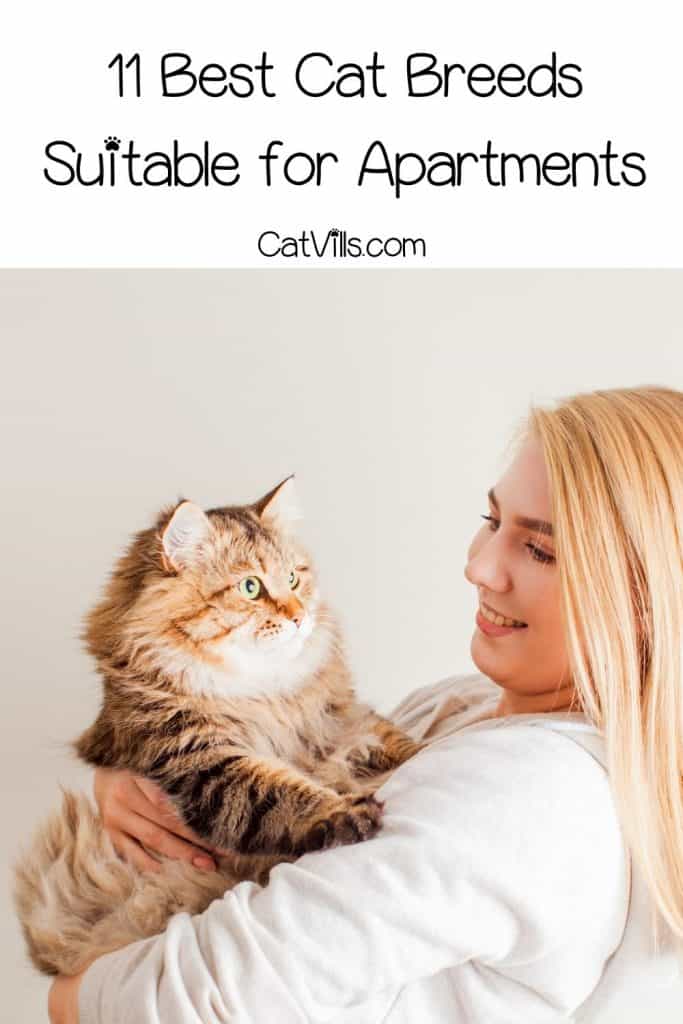

You have a fabulous list of cats here. They all sound like lovely ones.
I really enjoyed reading this post, thanks for sharing the apartment tips.
This is such a great guide. I don’t have an apartment but, it’s good to know the different types to consider.
I had a Russian Blue and I agree with you on all points. The perfect cat for any occasion, in my opinion!
This is perfectly suited to us. We’d love a cat but with the limited space it’s hard to know what to get.
Persian cats are my favourite! My aunty had one called Lindo when I was younger, and he was the most beautiful cat. Me and my partner just moved into a flat together, so this is really useful for us.
I never realized how many different breeds of cats there are, aside from wild cats. I would love to have a cat that had no shedding but I don’t want a fur-less cat either lol
I will definitely share this with my friend who loves cats and wanted to add more to her home.
My daughter wants a cat and we live in an apartment. These are very useful tips!
This is wonderful list and info. I learn lot of cats from your post. thanks for sharing this.
We are all dogs hear and it’s a lot. We did have a Russia Blue, but my niece wanted her so bad, and she has been there for years and they love her.
They are all so cute and lovely but I am rooting for Persian cats